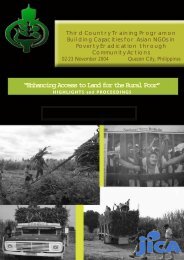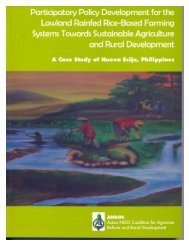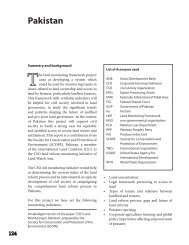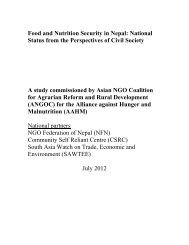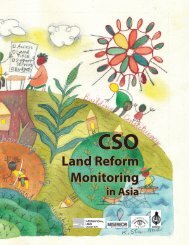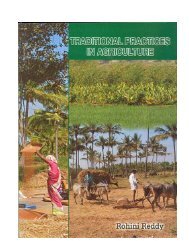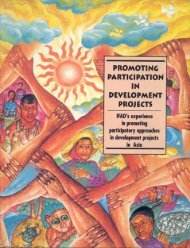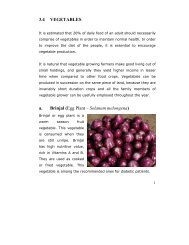Securing the Right to Land FULL - ANGOC
Securing the Right to Land FULL - ANGOC
Securing the Right to Land FULL - ANGOC
Create successful ePaper yourself
Turn your PDF publications into a flip-book with our unique Google optimized e-Paper software.
SECURING THE RIGHT TO LAND112<br />
Birta<br />
The term “Birta” was probably derived from <strong>the</strong> Sanskrit word<br />
Britti, which means livelihood. Hence, Birta refers <strong>to</strong> land granted<br />
<strong>to</strong> individuals <strong>to</strong> enable <strong>the</strong>m <strong>to</strong> make a living. Birta land is<br />
awarded <strong>to</strong> individuals by <strong>the</strong> state, tax-free, for <strong>the</strong>ir bravery or<br />
loyalty (Chapagain, 2001). The Birta owner has tenants working<br />
<strong>the</strong> land, from whom he—ra<strong>the</strong>r than <strong>the</strong> State—collects land<br />
tax. The Birta owner retained an agreed portion of <strong>the</strong> collected<br />
tax as his income and remitted <strong>the</strong> rest <strong>to</strong> <strong>the</strong> Government.<br />
There were two types of Birta: non-inheritable Birta and inheritable<br />
Birta. Ownership of non-inheritable Birta land lasts only<br />
during <strong>the</strong> recipient’s lifetime, while inheritable Birta could be<br />
sold or transferred <strong>to</strong> ano<strong>the</strong>r person. In many cases, however,<br />
non-inheritable Birta was transferred <strong>to</strong> <strong>the</strong> heir/s after <strong>the</strong><br />
death of <strong>the</strong> Birta owner (HLRC, 1995). Birta was not only <strong>the</strong><br />
source of income of <strong>the</strong> Birta owner but was also an indication<br />
of high social and economic status (Regmi, 1977). More than<br />
one-third (36.3%) of <strong>the</strong> country’s farmland was under this<br />
tenure type before <strong>the</strong> 1950s (Regmi, 1977).<br />
Birta tenancy was officially abolished with <strong>the</strong> promulgation of<br />
<strong>the</strong> Birta <strong>Land</strong> Abolition Act 2016 (1957), which required all<br />
Birtas <strong>to</strong> be converted in<strong>to</strong> Raikar. However, <strong>the</strong> abolition of<br />
Birta <strong>to</strong>ok effect only after <strong>the</strong> formation of <strong>the</strong> Nepali Congress<br />
government in 1959.<br />
Jagir, Rajya and Rakam<br />
Jagir refers <strong>to</strong> <strong>the</strong> system wherein <strong>the</strong> government authorized<br />
civil servants <strong>to</strong> collect land tax (in cash or kind) and <strong>to</strong> use it<br />
for a certain period of time in lieu of a salary. In this system, <strong>the</strong><br />
civil servant could not sell or transfer his right <strong>to</strong> his heir/s, nor<br />
<strong>to</strong> any o<strong>the</strong>r persons. However, <strong>the</strong> owner or tenant of Jagir land<br />
could do so (HLCR, 1995). This tenure system was abolished in<br />
1951 with <strong>the</strong> end of <strong>the</strong> Rana Regime in Nepal as most of <strong>the</strong><br />
Jagir assignees were Ranas. The abolition of <strong>the</strong> Birta and Jagir<br />
tenure systems signaled <strong>the</strong> disappearance of feudal lords from<br />
<strong>the</strong> agrarian scene in Nepal (Regmi, 1977).<br />
Rajya is ano<strong>the</strong>r type of land tenure which came in<strong>to</strong> effect<br />
after <strong>the</strong> unification of <strong>the</strong> country by Prithivi Narayan Shah,<br />
King of Nepal from 1723 <strong>to</strong> 1775. The unification abolished <strong>the</strong><br />
small fragmented kingdoms in <strong>the</strong> country. However, even after<br />
unification, <strong>the</strong> former kings (chiefs of certain terri<strong>to</strong>ries) were<br />
authorized <strong>to</strong> collect land tax from certain lands and could use<br />
<strong>the</strong> money freely. In some circumstances, <strong>the</strong>y had <strong>to</strong> pay a<br />
certain portion of <strong>the</strong> collected land tax <strong>to</strong> <strong>the</strong> State. This authority<br />
was assumed by heirs of <strong>the</strong> kings. However, <strong>the</strong>y had<br />
no authority <strong>to</strong> sell or reallocate land <strong>to</strong> different tenants. This<br />
right was vested in <strong>the</strong> tenants or landowners. This type of tenure<br />
was abolished in 1971 (HLCR, 1995).<br />
Rakam originated from <strong>the</strong> assignment of land as compensation<br />
for <strong>the</strong> performance of specific functions, mostly of a manual<br />
nature. Rakam lands were assigned <strong>to</strong> carpenters, bricklayers,<br />
mail carriers, wind-pipe players, caretakers of religious places,<br />
and similar categories of manual workers. This system was limited<br />
<strong>to</strong> <strong>the</strong> hill region of Nepal, particularly Kathmandu Valley<br />
(Regmi, 1977). Rakam was a temporary assignment and ended<br />
upon <strong>the</strong> death or termination of service of <strong>the</strong> assignee. The<br />
Rakam system was abolished in 1955, and Rakam lands were<br />
converted in<strong>to</strong> Raikar lands.<br />
About 7.7% of <strong>the</strong> country’s farmland is estimated <strong>to</strong> have been<br />
under Jagir, Rajya and Rakam prior <strong>to</strong> abolition (Regmi, 1977).<br />
None of <strong>the</strong>se tenurial systems is currently practiced.<br />
Kipat<br />
Kipat is land collectively owned and cultivated by <strong>the</strong> Limbu community<br />
in <strong>the</strong> hills of eastern Nepal for <strong>the</strong>ir own purpose. Kipat<br />
land could be sold, or rights <strong>to</strong> it transferred <strong>to</strong> members of <strong>the</strong><br />
same community but not outside it. Kipat landowners had <strong>to</strong><br />
pay tax <strong>to</strong> <strong>the</strong> State for <strong>the</strong> portion of <strong>the</strong> land used as homestead.<br />
Paddy lands were exempted from tax (Regmi, 1977). About<br />
4% of <strong>the</strong> nation’s farmland was under this tenure system. It was<br />
abolished in 1961 by a government decree that converted Kipat<br />
land in<strong>to</strong> Raikar following a survey of <strong>the</strong> land (Regmi, 1977). All<br />
Kipat lands have since been converted in<strong>to</strong> Raikar (HLCR, 1995).<br />
Guthi<br />
The term Guthi was probably derived from <strong>the</strong> Sanskrit Gosti, or<br />
council. Guthi refers <strong>to</strong> land allocated for <strong>the</strong> purpose of covering<br />
<strong>the</strong> expenses of certain religious, charitable, cultural, or social<br />
functions. Guthi lands were registered <strong>to</strong> religious/cultural<br />
institutions by <strong>the</strong> State. However, individuals could also offer<br />
<strong>the</strong>ir land as Guthi. Guthi land is exempted from taxes.<br />
The tenure right of tenants cultivating Guthi land is transferable<br />
<strong>to</strong> o<strong>the</strong>r tenants and is inheritable. At present, Guthi lands<br />
are administered by Guthi Sansthan (Guthi Corporation). About<br />
2% of <strong>the</strong> nation’s farmland belongs <strong>to</strong> this tenure type. How-



